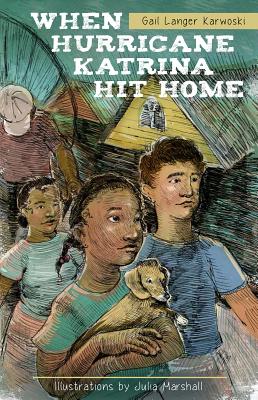WHEN HURRICANE KATRINA HIT HOME
 Gail Langer Karwoski, illustrations by Julia Marshall
Gail Langer Karwoski, illustrations by Julia Marshall
Good news update! WHEN HURRICANE KATRINA HIT HOME was selected as a Notable Book for Older Readers by the Sydney Taylor Awards, the Association of Jewish Libraries.
What a shock to everyone who decided to wait out the storm. Hurricane Katrina burst levees, flooded acres of homes, and destroyed entire neighborhoods. What made the difference between death and survival?
The color of one’s skin? Being rich or being poor? Being prepared for one of the worst storms to hit New Orleans? Or stubborn courage?
Gail Langer Karwoski wrote about Hurricane Katrina using alternating voices and perspectives of two very different characters– Chazz and Lyric. Lyric lives in the Ninth Ward where people are poor and have few resources, such as a car to get them quickly out of town. When the rushing flood waters rose higher than windows and doors, they have nowhere to go but to flee to the rooftops of their homes and hope the rising flood waters don’t topple them over or wash them away. Or leave them stranded without food or water.
Chazz lives in the wealthy Garden District of New Orleans. Money or resources were not a problem. But for Chazz, family was a problem, specifically the absence of a parent who is always “away,” too busy, even when the biggest storm of the century threatens his safety.
Hurricane Katrina hits harder, faster and bigger than anyone predicted. New Orleans is unprepared. Crisis becomes chaos. No electricity, no cell service, no way to find out what’s happening or how to get help. The wind whips stronger, the water rises higher. Chazz and Lyric live in very separate parts of the city. Their lives are usually worlds apart. Suddenly they share a common goal – survival!
Do they have the courage to risk their own lives, their family’s safety, to help each other?
This story will keep you turning pages and also thinking about the courage it takes to fight to survive… and help others.
Gail has written several books about major disasters. I read Gail’s book about the terrible tsunami that hit the Hilo area on the Big Island of Hawaii. Then I had to read her book about the San Francisco earthquake, Quake! Disaster in San Francisco, 1906. I contacted Gail to ask about this book. Her replies are as interesting as the stories she writes:
Q. Why did you choose to write this book with two perspectives? Did you have two families in mind before writing the story?
Gail: I started out writing this book with a single narrator – Chazz. I chose him because he was NOT from a poor neighborhood! I wanted to show that ANYONE can get stuck in a scary, terrible situation when a disaster strikes.
Every person who got trapped by New Orleans flood waters had their own story to tell. I learned this when I went to New Orleans and interviewed people before I started writing. I also read lots of books full of eyewitness accounts. Although everybody’s story was a little different, the pattern was the same: Each person had a very good reason for deciding to stay in New Orleans during the storm. Each person took measures to protect themselves, but they had no way of knowing that the levees would break and lake waters would flood the city. During the disaster, people did whatever they could to survive, and they tried to help others who were in trouble.
As I wrote, another character in my story started to intrigue me. That was Lyric. I experimented – just for the fun of it – and let her tell parts of the story from her perspective. I liked what she said! Her point of view made the story richer. She had different insights than Chazz. She understood things that he missed. Each of these children came to the storm with different life-experiences. As our guides into this disaster, each of the kids offered valuable information. In the end, I couldn’t decide which narrator was best, so I kept both!
Q: Why do you write about real disasters, such as earthquakes, tsunami, and now, a hurricane?
I’m fascinated by survival stories. Yes, I’ve experienced earthquakes and hurricanes – but not deadly ones. These events are metaphors for the actual disaster in my own childhood. That was my mom’s death from cancer. At the time, I thought that was the worst thing that could ever happen. I didn’t know any other kids who had a mom who died, so I felt alone and confused.
Research about what happens during a disaster, confirms the hard lesson from my childhood: Even after something awful happens, we can survive. Disaster shakes us to our core, but we find the strength we need. In the worst of times, we reach out and help each other. We come away as better people.
Thank you, Gail, and congratulations on the book’s Sydney Taylor Award, a wonderful recognition well deserved.